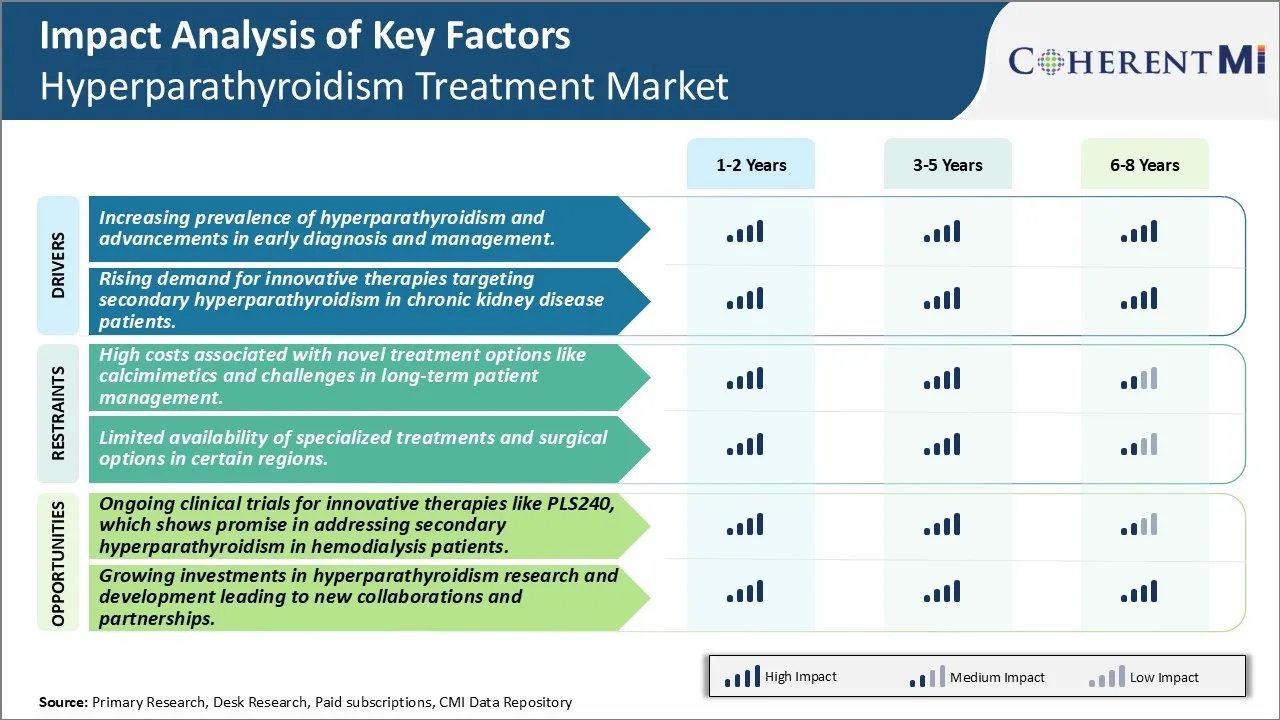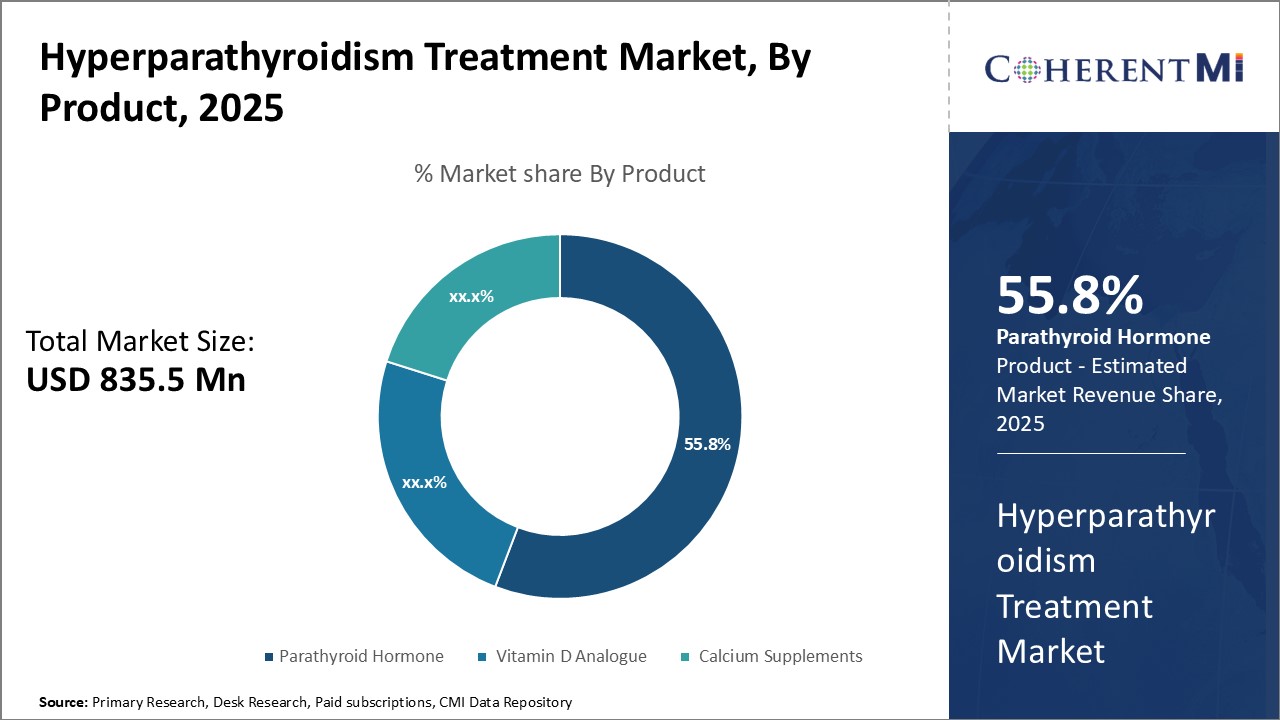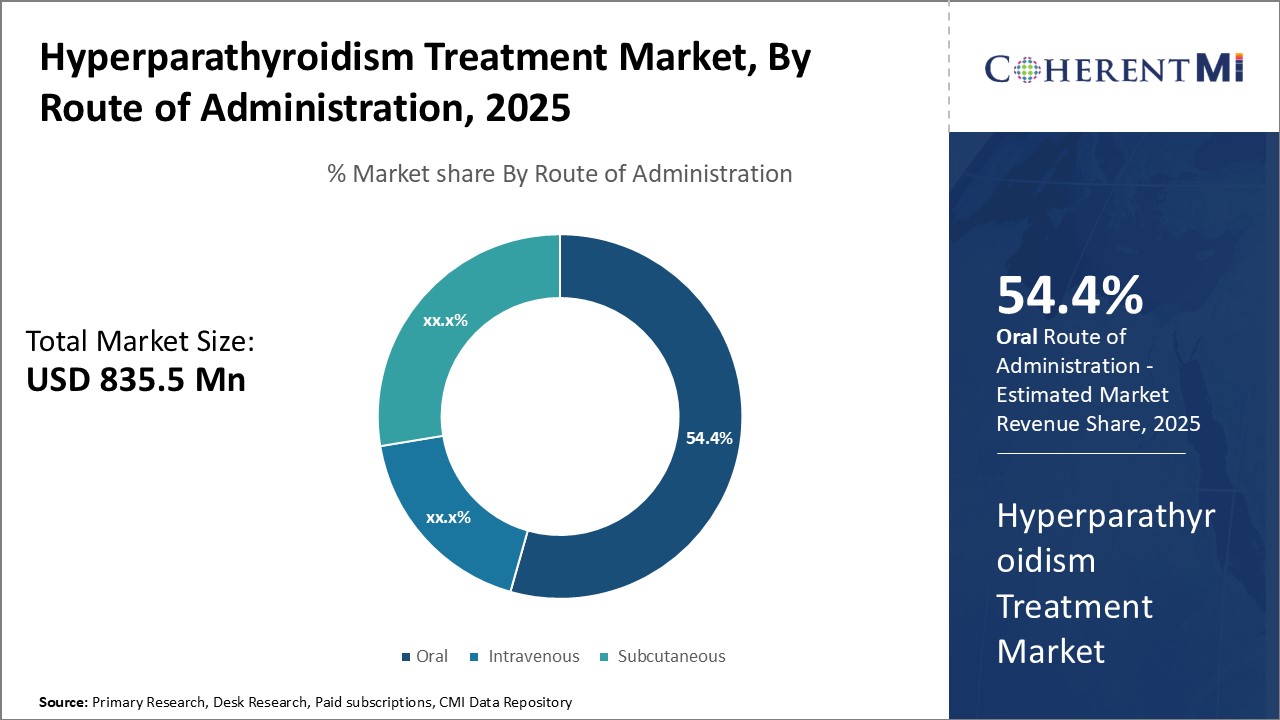Hyperparathyroidism Treatment Market Size - Analysis
The Global Hyperparathyroidism Treatment Market is estimated to be valued at USD 835.5 Mn in 2025 and is expected to reach USD 1350.4 Mn by 2032, growing at a compound annual growth rate (CAGR) of 7.1% from 2025 to 2032.
Market Size in USD Mn
CAGR7.1%
| Study Period | 2025-2032 |
| Base Year of Estimation | 2024 |
| CAGR | 7.1% |
| Market Concentration | Medium |
| Major Players | Pathalys Pharma, Amgen Inc., Takeda Pharmaceutical Company Limited, Sanofi S.A., Roche Holding AG and Among Others |
please let us know !
Hyperparathyroidism Treatment Market Trends
Hyperparathyroidism condition occurs due to overproduction of parathyroid hormone from the parathyroid glands located in the neck region. The exact causes behind the overproduction of this hormone are yet to be fully understood, however genetic and environmental factors are known to play a significant role. With changing lifestyle patterns and dietary habits, the prevalence of hyperparathyroidism has been steadily increasing over the past few decades. Long term intake of diet low in calcium and vitamin D makes individuals prone to this disorder. Also, family history of this condition elevates the risk. As per estimates, about 1 in every 1000 individuals might be suffering from hyperparathyroidism without even realising it.
Along with early diagnosis, management of hyperparathyroidism has also improved significantly in recent times. Minimal invasive surgical methods like video-assisted parathyroidectomy and radioimmuno-guided parathyroidectomy are gaining popularity over traditional bilateral neck exploration. These focussed localization approaches result in lower complication rates and swifter recovery compared to conventional surgery.
Market Driver - Rising Demand for Innovative Therapies Targeting Secondary Hyperparathyroidism in Chronic Kidney Disease Patients.
Recently, recombinant human PTH (rhPTH) has shown promising results as an adjunct treatment to conventional regimens. Drugs like teriparatide acts by intermittent administration of PTH analogous to normal daily hormonal fluctuations helping restore normal bone remodelling. Other emerging therapies are antibodies targeting excess PTH like burosumab. Cinacalcet continues to play a significant role as an additional PTH lowering option for those refractory or intolerant to conventional lines. Currently, late phase clinical trials are evaluating next generation therapies combining calcimimetics with other agents or drug delivery systems like nanoparticles for prolonged efficacy. Should ongoing research efforts prove fruitful, availability of superior treatment alternatives are certain to strengthen market potential further in coming years.

Market Challenge - High Costs Associated with Novel Treatment Options Like Calcimimetics and Challenges In Long-Term Patient Management.
One of the key opportunities in the hyperparathyroidism treatment market lies in the ongoing clinical trials for innovative new therapies. For instance, Paladin Labs' investigational drug PLS-240 is currently being evaluated in Phase 3 trials for the management of secondary hyperparathyroidism in patients on hemodialysis. If successful, PLS-240 has the potential to address an important unmet need as an oral therapy offering an alternative to existing injectable drugs like calcimimetics. Several other drug candidates targeting parathyroid hormone, calcium sensing receptors and phosphate homeostasis are also in early to mid-stage trials. A strong clinical pipeline offers hope that the next few years could see the approval and launch of novel treatment options addressing the shortcomings of current therapies. This would help drive market revenues by expanding treatment patterns and enabling more effective long-term management of both primary and secondary hyperparathyroidism. Promising candidates emerging from the trial phases bode well for sustained growth opportunities in the future.
Prescribers preferences of Hyperparathyroidism Treatment Market
Hyperparathyroidism is typically treated in a step-wise manner based on disease severity and symptoms. For mild asymptomatic cases, initial treatment involves lifestyle modifications like diet and exercise to control serum calcium levels.
For those who fail medical therapy or are intolerant to side effects, surgery becomes the preferred option. Parathyroidectomy, which involves removing one or more of the parathyroid glands causing the excess hormone secretion, provides the best chance of cure. Over 95% of patients experience complete remission after surgery when all abnormal glands are correctly identified and removed.
Other factors influencing treatment choices include disease severity, comorbidities, progression of symptoms, costs, patient preferences and risks of invasive procedures. Close monitoring of lab parameters allows prescribers to customize therapy based on each case's unique profile.
Treatment Option Analysis of Hyperparathyroidism Treatment Market
Hyperparathyroidism has different stages of progression based on severity of symptoms. Early stage or asymptomatic hyperparathyroidism may only require lifestyle modifications and monitoring. Advanced stages may require drug therapies or surgery.
In moderate cases, drug options are considered. Cinacalcet (Sensipar) is a first-line drug that reduces calcium levels by inhibiting parathyroid hormone secretion. It is taken orally and generally well-tolerated long-term with minimal side effects.
In recalcitrant cases where all glands appear overactive, total parathyroidectomy with auto transplantation of parathyroid tissue is performed. This offers the best chance of cure while maintaining post-operative calcium metabolism.
Key winning strategies adopted by key players of Hyperparathyroidism Treatment Market
Focus on R&D and New Product Launches: Several players have focused aggressively on R&D activities to develop new and improved treatment options for hyperparathyroidism.
Focus on Specialized Segments: Some players have developed winning strategies targeting specific patient segments like those with moderate-to-severe hypercalcemia.
Segmental Analysis of Hyperparathyroidism Treatment Market
 Insights, By Product, Parathyroid Hormone Drives the Product Segment Due to Its Targeted Mechanism of Action.
Insights, By Product, Parathyroid Hormone Drives the Product Segment Due to Its Targeted Mechanism of Action.By Product, Parathyroid hormone is expected to account for 55.8% share in 2025. This is because parathyroid hormone offers a targeted mechanism of action for treating hyperparathyroidism that is not found in other product types.
Parathyroid hormone acts directly on the parathyroid glands to help restore normal parathyroid hormone secretion. By targeting the glands that produce excess parathyroid hormone, it addresses the root cause in a precise manner. Other product types like vitamin D analogues and calcium supplements do not focus treatment in the same targeted way.

Insights, By Route of Administration, Oral Administration Dominates Due to Convenience.
For patients needing lifelong control of their hyperparathyroidism, oral therapy offers lifestyle practicality that intravenous and subcutaneous options cannot match. With oral medications, patients do not need to undergo injections or infusions. This eliminates burdens like visiting clinicians' offices or self-administering treatments. The ease of oral therapy promotes higher medication adherence. Patients are more likely to strictly follow their prescribed oral regimen without disruptions. This improves health outcomes, as maintaining close control of hyperparathyroidism is important. Other administration routes risk non-adherence due to issues like inconvenient scheduling of visits or patient discomfort with medical procedures.
Additional Insights of Hyperparathyroidism Treatment Market
Hyperparathyroidism is a common endocrine disorder marked by the overproduction of parathyroid hormone (PTH), which causes elevated calcium levels in the blood and associated complications like kidney stones, bone weakness, and fatigue. Diagnosis typically involves blood tests to measure calcium and PTH levels, along with imaging to detect any gland abnormalities. There are three forms of hyperparathyroidism: primary, secondary, and tertiary, each with distinct causes and treatment approaches. Primary hyperparathyroidism is often caused by a benign tumor, while secondary hyperparathyroidism is usually linked to chronic kidney disease or vitamin D deficiency. Treatment can range from watchful waiting in asymptomatic cases to surgical removal of the affected glands or the use of medications like bisphosphonates or calcimimetics. Pathalys Pharma is developing PLS240, an emerging calcimimetic in Phase III trials, which promises to enhance the treatment of secondary hyperparathyroidism in patients undergoing dialysis. The development of new therapies such as PLS240, along with advances in early detection and management, is expected to drive growth in the hyperparathyroidism therapeutics market in the coming years.
Competitive overview of Hyperparathyroidism Treatment Market
The major players operating in the Hyperparathyroidism Treatment Market include Pathalys Pharma, Amgen Inc., Takeda Pharmaceutical Company Limited, Sanofi S.A., Roche Holding AG, Novartis AG, AbbVie Inc., Kyowa Kirin Co., Ltd., Shire Pharmaceuticals, Radius Health Inc. and OPKO Health, Inc.
Hyperparathyroidism Treatment Market Leaders
- Pathalys Pharma
- Amgen Inc.
- Takeda Pharmaceutical Company Limited
- Sanofi S.A.
- Roche Holding AG
Hyperparathyroidism Treatment Market - Competitive Rivalry

Hyperparathyroidism Treatment Market
(Dominated by major players)
(Highly competitive with lots of players.)
Recent Developments in Hyperparathyroidism Treatment Market
In May 2024, Pathalys Pharma announced the development of PLS240 (upacicalcet), a novel calcimimetic currently in Phase III clinical trials for the treatment of secondary hyperparathyroidism in hemodialysis patients. This drug offers the potential to improve the management of elevated parathyroid hormone levels, providing a new treatment option for patients suffering from chronic kidney disease.
Hyperparathyroidism Treatment Market Segmentation
- By Product
- Parathyroid Hormone
- Vitamin D Analogue
- Calcium Supplements
- By Route of Administration
- Oral
- Intravenous
- Subcutaneous

Would you like to explore the option of buying individual sections of this report?
Ghanshyam Shrivastava - With over 20 years of experience in the management consulting and research, Ghanshyam Shrivastava serves as a Principal Consultant, bringing extensive expertise in biologics and biosimilars. His primary expertise lies in areas such as market entry and expansion strategy, competitive intelligence, and strategic transformation across diversified portfolio of various drugs used for different therapeutic category and APIs. He excels at identifying key challenges faced by clients and providing robust solutions to enhance their strategic decision-making capabilities. His comprehensive understanding of the market ensures valuable contributions to research reports and business decisions.
Ghanshyam is a sought-after speaker at industry conferences and contributes to various publications on pharma industry.
Frequently Asked Questions :
How Big is the Hyperparathyroidism Treatment Market?
The Global Hyperparathyroidism Treatment Market is estimated to be valued at USD 835.5 Mn in 2025 and is expected to reach USD 1350.4 Mn by 2032.
What will be the CAGR of the Hyperparathyroidism Treatment Market?
The CAGR of the Hyperparathyroidism Treatment Market is projected to be 6.9% from 2024 to 2031.
What are the major factors driving the Hyperparathyroidism Treatment Market growth?
The increasing prevalence of hyperparathyroidism and advancements in early diagnosis and management. Rising demand for innovative therapies targeting secondary hyperparathyroidism in chronic kidney disease patients. These are the major factors driving the Hyperparathyroidism Treatment Market.
What are the key factors hampering the growth of the Hyperparathyroidism Treatment Market?
The high costs associated with novel treatment options like calcimimetics and challenges in long-term patient management and the limited availability of specialized treatments and surgical options in certain regions. These are the major factors hampering the growth of the Hyperparathyroidism Treatment Market.
Which is the leading Product in the Hyperparathyroidism Treatment Market?
Parathyroid Hormone is the leading Product segment.
Which are the major players operating in the Hyperparathyroidism Treatment Market?
Pathalys Pharma, Amgen Inc., Takeda Pharmaceutical Company Limited, Sanofi S.A., Roche Holding AG, Novartis AG, AbbVie Inc., Kyowa Kirin Co., Ltd., Shire Pharmaceuticals, Radius Health Inc., OPKO Health, Inc. are the major players.